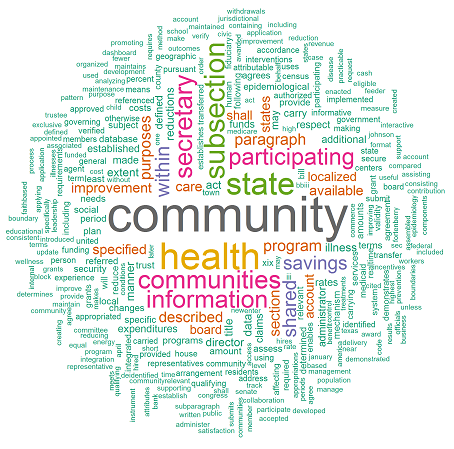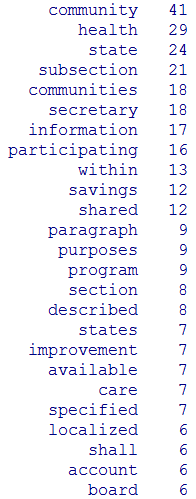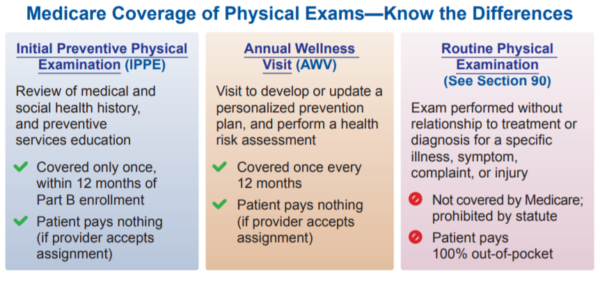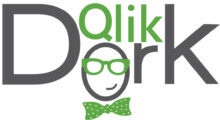
Visualizing HR 660
Politics is a topic we are supposed to stay away from. It turns friends into enemies. Plus House Resolutions are just a bunch of boring text who has time for all that jazz. Certainly won’t find any in other data visualization blogs so why here.
Well my friends HR 660 isn’t just any other House Resolution and it’s about Population Health which you know is my jammy jam. You can read the entire text here but as this is primarily a visualization blog let’s visualize it.

Community
Word Clouds present the words from text, say HR 660, in a form where the words that are used the most are larger so that they stand out. Without any commentary from me and without reading the bill itself you should be able to immediately recognize that this bill is about “community” “health.” That’s the beauty of data visualization. Your eyes should be drawn to immediate insights.

Oh wait I hear my data friends shouting … “but how many times were those used I can’t hover over the image inside your blog.” So before they whine to loudly and miss the rest of my post here it is.
If you look at the frequency of “community” and “communities” you will see that it is referred to 59 times.
Clearly this bill is all about the community. Whis is exactly what I would expect being that my friend Fred Goldstein helped put it together and is leading a charge to get this thing passed. Fred is all about … ta dah … Community Health as the President and Founder of Accountable Health.
Child Actors?
I follow Fred on Twitter and 99.9999% of the time I immediately understand what he is writing about. I recently saw a post from him telling people to get behind HR660 the CHILD Act.
I thought well this is odd usually Fred is all about health. Why would he care about a house bill to support children actors? So I reached out to him. He immediately explained I was way off base and CHILD stands for “Community Health Improvement and Leadership Development.”
Now that’s more like it. I asked Fred if I could interview him and he graciously agreed. I took notes but didn’t actually record the interview since it was for a blog, not a Dork Cast. I feel the need to share that as a courtesy to my friend he is a brilliant man. If my response marked “Fred” seems goofy I probably took some liberties in adding humor.
Background commentary
A small amount of background is probably needed before the interview so here goes. HR 660 is sponsored by Congressman Jeff Fortenberry (R NE). It is also has bipartisan sponsorship from Eddie Bernice Johnson (D TX) and J French Hill (R AR).
Fred worked with Reyn Archer , MD who is the Chief of Staff for Congressman Fortenberry and former Commissioner of Health for the State of Texas . Reyn has a history of working on public policy in health, nutrition and international development. He also worked with Douglas Goldstein who works on all sorts of things a technology Dork like me appreciates. More importantly to this post he focuses on behavioral economics to improve health and happiness that the population health side of me appreciates.
Interview
Qlik Dork: Seems incredible that overnight you started working with such great folks on such an ambitious and bold goal.
Fred: More like over a few thousand nights. When I was part of the Population Health Alliance I proposed a similar but different approach. My original design was that it would be a community based health plan. All of the people on the same street/same community would be on the same insurance plan. As a community they would share in any savings they were able to achieve and the money would come back to their community.
Qlik Dork: What was your thinking behind such an approach?
Fred: Population Health is a very abstract theory until it is implemented within communities themselves. That people are much more likely to participate and hold each other accountable if they are incentivized to do so.
Qlik Dork: I love that concept. I know that in my own life I would like to be more active, but I’m hit or miss on achieving it. But I’m nearly 100% when a friend comes by and invites me to walk or do something with them.
Fred: That was the idea. Improve health behaviors while also leveraging and improving the social networks within a community. I called them Havens of Health.
Qlik Dork: I take it your Health Plan concept never really got off the ground since you said that was years ago and was your original design.
Fred: Launching a health plan is a big lift and while CMMI expressed interest when I met with them, finding a community and getting the funding has proven difficult. But, I haven’t given up and others are beginning to look more closely at similar models.
Qlik Dork: I can imagine. In what I read from HR 660 it sounds very similar but slightly different. Can you explain to me the highlights of the Child Act?
Fred: The bill is the brainchild of Reyn who was introduced to me by Doug after Doug learned of my community owned Medicaid health plan idea. Reyn’s concept was to create a Community Health Savings Accounts instead of a full blown health plan. That concept is what ultimately became HR 660, which creates a Community Shared Savings Account for Medicaid. . If the communities are able to demonstrate a savings then 70% of the savings goes back into the community.
Qlik Dork: Are the savings going to be stacked up in a pile of dollars or something for neighbors to come and grab?
Fred : Not quite. The bill requires the appointment of a local community board and they would choose how the money would be spent within their community.
Qlik Dork: That probably makes more sense.
Fred: The community leadership might use the money to enhance a park, build sidewalks or whatever they deem necessary to keep the healthy momentum going.
Qlik Dork: So basically they could use the money to address the Social Determinants of Health that they as a community, really feel need addressed.
Fred: You caught on pretty quickly. We know that Social Determinants of Health are real, and are important but the idea that a Health System or insurance company knows what is best for individual communities and neighborhoods is kind of silly. Each is unique. Putting the control within the communities themselves provides more accountability for the residents themselves.
Qlik Dork: One of the concepts that I learned from Drew Harris at the Jefferson Population Health Academy was a term called Social Contagiousness. It sounds like HR 660 is intended to try and help residents want to not only become healthier but spread those healthy behaviors.
Fred: That’s pretty much it in a nutshell. Provide the incentive for the community and the individual to change behaviors and continue that ball rolling.
Qlik Dork: Fred I’ve got to tell you that is a pretty bold goal.
Fred: It is. But we aren’t going to change the health system by thinking small or even by thinking that would be considered reasonable. Affecting policy change on a large scale is something I’m passionate about.
Qlik Dork: Growing up I loved watching the Schoolhouse Rock special on how a bill becomes a law it must be the thrill of a lifetime to be working on this bill.
Fred: It is a thrill because I believe in it, but it isn’t my first time.
Qlik Dork: Get out of here. What other things have you worked on.
Fred: I am proud to say that I helped get a provision into the Affordable Care Act.
Qlik Dork: I love provisions … what was it?
Fred: It was GO438
Qlik Dork: Help a brother out … that seems cryptic.
Fred: Most CPT codes are Dalton. GO438 is the CPT code for a Medicare Wellness Visit …
Qlik Dork: So a physical.
Fred: That’s the misperception because most people don’t read the whole code description which is “Annual wellness Visit, including a personalized prevention plan of service (PPPS), first visit.”

Qlik Dork: Wow and people tell me I’m verbose. That seems awfully descriptive. I’m assuming the personalized prevention plan is where it differs from a regular physical.
Fred: You are correct. It involves the physician working with the patient to understand their health risks and document a 5 year preventative plan for how to stay ahead of those risks. Best part for those on Medicare G0438 is covered while annual physicals are not.
Qlik Dork: Wait a minute. Are you saying that those on Medicare have to pay out of their own pockets for physicals, but if they have a GO438 they can focus on a plan for health instead of just dealing with sickness and it’s paid for. I’m not a senior yet, but that is flat out awesome.
Fred: Exactly. With the added benefit that it’s about preparing to stay healthy rather than waiting to treat the sickness.
Qlik Dork: No wonder we get along so well together. I feel like a broken record when I challenge peoples use of EHR or EMR and tell them I call it an Electronic Sickness Record and we should use ESR instead. What can I or my 3 readers do to help?
Fred: Pretty simple. Tell them to read the bill. If they believe in communities being more proactive in becoming healthier instead of treating sickness. If they believe it should be the communities themselves who should share in the savings. Lastly if they believe that the communities should dictate how their specific community could best put funds to use to continue to improve health they should contact their congressperson. And if they want more information they can always reach out to me [email protected].
Call to Action
Personally there are times I feel overwhelmed by the mess that the healthcare system is in. I feel like there is nothing I can. That the players behind the system will never change. But then I have some Mountain Dew and I realize the system will never change unless people 1 by 1 start standing up and demanding change. I understand how politics can be divisive. But hopefully HR 660 is one thing we can all agree is a positive step forward. I encourage you to read it, contact your congressperson, and support it on social media using #HR660ChildAct and @CongressDotGov.
Update 5/2/2019 – Fred was recently interviewed on the “Unlocking Accountable Care” Podcast and details the bill so check it out.
http://dayhealthstrategies.com/podcast-unlocking-accountable-care-episode-13-community-based-interventions/


Pingback:Do you really analyze ALL your data in Qlik? - INPHINITY
Pingback:Is unstructured data worthy of your time? What do Qlik luminaries think? - INPHINITY